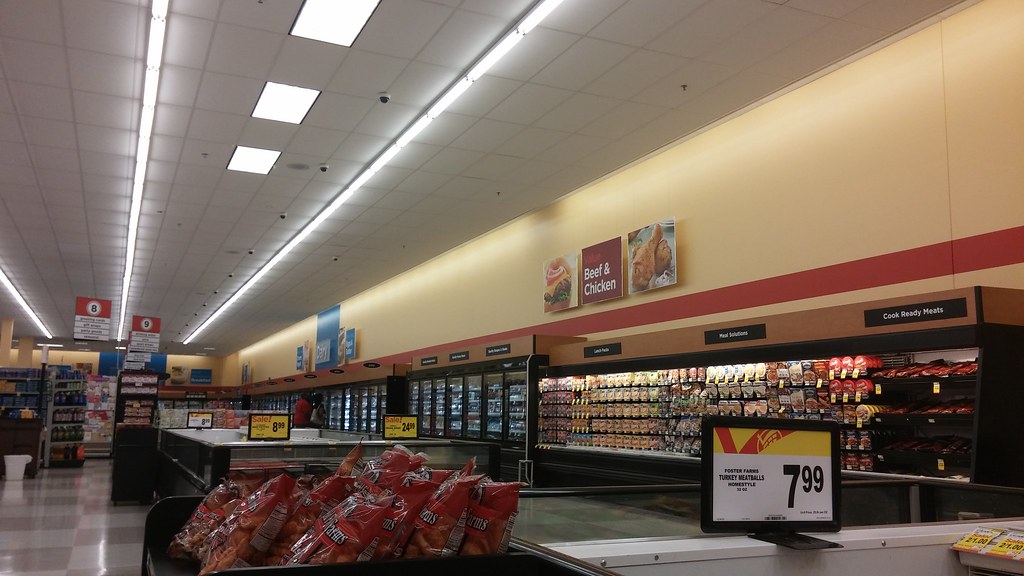What is Shoppers Food Warehouse & Pharmacy? (thanks, SuperValu...)
Shoppers Food & Pharmacy is a discount grocery store chain comprised of approximately 56 locations in Virginia and Maryland. As I've been saying The chain has roots in Jumbo Food, run by the Herman brothers (Irving and Kenneth) which started the Shoppers Food Warehouse stores in 1978.
Early era (1978-1989)
The first store to open opened in Alexandria, VA at the former site of a Safeway (Marina-style) in late 1978 (now a New Grand Mart). Over the next few years, more stores opened dotted about the area, such as in Fairfax, Olney, and Capitol Heights. Shoppers was expanding rapidly, thanks to its' low-price concept featuring national brands. In the late 1980s, the reins were handed over to the (in)famous Herbert Haft and crew. Jumbo Food also dissolved into the company, now Shoppers Food Warehouse Corp.
Major growth and Shoppers Club (1989-1994, 1994-1999)
With the company prevailing in new stores, a new, bigger concept was called for. Shoppers Club stores expanded the original formula and brought a whole new dimension of retailing to Shoppers. New features were showcased such as greatly expanded delis/prepared foods and a complementary Shoppers Café, a cheese display, expanded beverage sections, and most importantly, new "club paks", which showcased products in expanded quantities.
The Woodbridge (relocation), Germantown, Manassas (Bull Run Plaza), and other locations were opened/expanded in 1994 and 1995, while stores in Fredericksburg (now closed), Falls Church, and Alexandria (Potomac Yard) were opened respectively in 1997. Other stores such as College Park, Clinton (expansion), and Sterling (expansion) came online later.
Meanwhile, Shoppers' ownership was quickly changing from one to another. Dart's stake in Shoppers was fully expanded in late 1996, which led to some controversy. After a full year under the Hafts, Richfood (already owning Maryland/Delaware chain Metro) swooped in and purchased the retailer.
With the chain still performing well, SuperValu acquired Richfood to expand further in the summer of 1999.
Early SuperValu era (1999-2003)
At the time of the SuperValu purchase, Shoppers was getting pharmacies and banks (by Provident) into gear. Contrary to belief, these were not present prior to the takeover.The first stores under the Minneapolis grocery conglomerate were remodels/relocations of stores in the chain throughout the early 2000s. Some had desperately needed a makeover due to their age/size/layout. Other changes were happening in these stores, as the warehouse price-impact look was slowly diminished in favor of orienting to shoppers of competing chains Giant and Safeway. Shoppers purchased four SuperFresh locations in 2002, further expanding their reach and new ideals.
Metro conversions and "upscale" era (2003-2008)

The Shoppers in Essex, MD, a former Metro. This store opened circa 2003. Credit: Will (B-More Retail)
For 2003, Shoppers and SuperValu acquired 15 Metro Food stores in the Baltimore region, converting them into Shoppers stores. For this new batch of stores, the chain was rechristened as Shoppers Food & Pharmacy (like other SuperValu-owned chains) and a whole new decor package was rolled out. New colored department signage and a brighter look erased Shoppers' lower-end past for a more expanded look, also building on Shoppers Club further. The former Metros were completed in early 2004, while other newbuild stores in Gainesville (now closed) and Manassas also opened.
 |
| The interior of the (now remodeled) Dumfries, VA Shoppers. This store opened in 2005. Credit: me (BatteryMill Retail) |
It was this time when SuperValu became a growing influence on the chain. A new website and new ad campaigns were launched to change Shoppers' image even more. Technologies were also upgraded to modern standards.
Modern era (2008-present)

The Shoppers in Annapolis, MD's interior. Credit: Will (B-More Retail)
In the fall of 2008, SuperValu unleashed a brand new look for Shoppers inside, inspired by their other chains like Acme, Albertsons, and Cub Foods. This package was also a radical departure in ways that changed ad campaigns once again. Several stores used this package, as well as the extensively-remodeled Annapolis store, which itself was once an Acme.
2010 brought another new package, which is presently used in many stores. This package features basic colored walls (reminiscent of the mid-2000s decor) with clear signs, which debuted in the renovated Burke, VA store. This package is inline with the rest of the SuperValu company.
In early 2011, SuperValu announced store closings for several locations. The Gainesville, Fredericksburg, Owings Mills, Timonium, and later Adelphi (former Jumbo Food), Chantilly, and Alexandria (Penn Daw) were all shuttered. Shoppers also bought out a former SuperFresh in Ellicott City, MD later in the year and converted it to a Shoppers.
 |
| A recent Shoppers remodel in Laurel, MD. Credit: Will (B-More Retail) |
Conclusion
Alright! This finishes a complete and detailed background of Shoppers Food's history. More posts will be on the way soon with even more to explore into the chain. Anyways, that's all for now. Hope to see you soon here!Sources:
- My (and others') personal knowledge
- https://www.shoppersfood.com/
- https://en.wikipedia.org/wiki/Shoppers_Food_%26_Pharmacy
- http://www.referenceforbusiness.com/history2/31/Shoppers-Food-Warehouse-Corporation.html
No comments:
Post a Comment